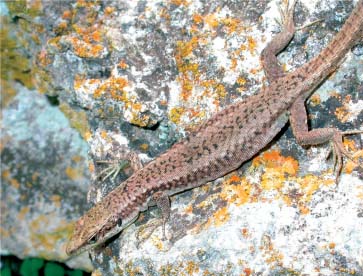Rostombekov's lizard: Red Data Book of Armenia

Lacertids — Lacertidae
Status. Listed in the IUCN Red List of Threatened Species (ver. 3.1) as Endangered EN B1ab(i,iii). According to IUCN criteria categorized as Endangered EN B2ab(ii, iii).
Distribution. The range is restricted to Northern Armenia and the adjacent areas of Azerbaijan. The core is located on the right bank of the middle Kura riverside and in the canyons of its right tributaries within Georgia, Northern Armenia and Northwestern Azerbaijan.
Distribution in Armenia. Limited to woodlands within northern Armenia. The southern boundary is stretched through the Pambak and Aghstev riparian canyons and along the Bazum Ridge to the east of Spitak town. The northern boundary goes by the north–east of the Papakar Ridge where the northernmost records come from the Noemberian and Sevkar districts. Moreover, an isolated population is known from the south–eastern shoreline of the Lake Sevan, near the Tsovak village.
Habitats. Occurs mostly in the forest zone, sometimes penetrating to grasslands, at 800–1600 m above sea level. The only population recorded on the Sevan shoreline lives at 2000 m above sea level.
Biological traits. The hibernation period ends in late March to early May. Feeds on insects and other small invertebrates. Reproduction through parthenogenesis. Two to four eggs are laid from late June to early July. Hatchlings emerge from late August to early September.
Population size and its trends. Surveys in typical habitats may reveal 50–60 lizards per 1 km of route.
Major threats. Economic activities in mountain grasslands and habitat deterioration. The Sevan population is teetering on the brink of extinction as ousted by sympatric D. unisexualis, a competitor better adapted to high mountainous conditions.
Conservation measures. Protected in Dilijan National Park and Sevan National Park.
Suggestions
 The Ministry of Environment sent a letter international partners to draw their attention to the real danger of environmental disasters as a result of Azerbaijan's large-scale aggression towards the territory of Armenia
The Ministry of Environment sent a letter international partners to draw their attention to the real danger of environmental disasters as a result of Azerbaijan's large-scale aggression towards the territory of Armenia
 Vicia pisiformis: Red Data Book of Armenia
Vicia pisiformis: Red Data Book of Armenia
 Vavilovia formosa: Red Data Book of Armenia
Vavilovia formosa: Red Data Book of Armenia
 Trigonella capitata: Red Data Book of Armenia
Trigonella capitata: Red Data Book of Armenia
 Trigonella astroides: Red Data Book of Armenia
Trigonella astroides: Red Data Book of Armenia












